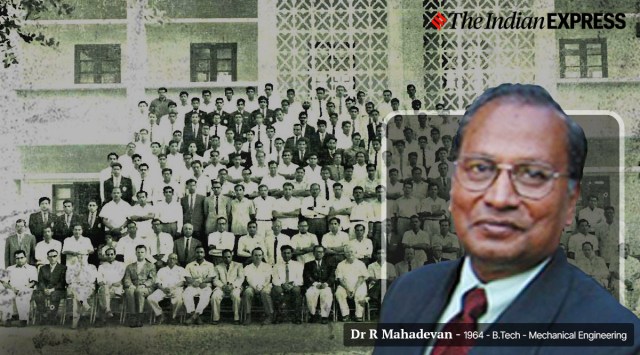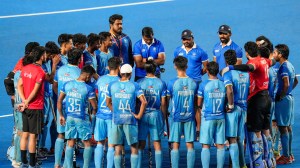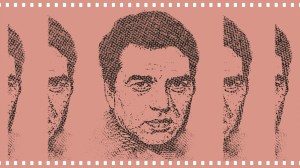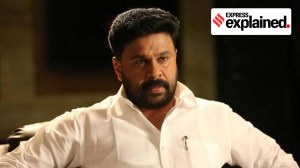In 1959, IIT-Madras was formally inaugurated with the help of the German government which provided technical, academic and financial assistance. Unlike these days, when an aspirant has to crack JEE Main and then Advanced to secure a seat at IIT, back then, admissions were done on the basis of PUC (pre university certificate equivalent of Class 12) marks followed by the interview round, says 80-year-old Dr R Mahadevan, from the first batch of IIT-Madras.

Sharing a slice from the interview he had to face, Mahadevan says, “During my interview, one of the German professors asked ‘which place are you from and tell us one famous thing about it?’ I answered that I am from Kumbakonam and it is known for its intellectuals. He smiled and quickly asked to name one intellectual and I said famous mathematician S Ramanujan. Co-incidentally he knew him as he was a maths professor. He announced ‘Congratulations, you have got admission.”
IIT Madras at that time offered five BTech courses – Mechanical, Electrical, Civil, Chemical and Metallurgy and the fees was Rs 500. A total of 120 students were admitted in the first batch. Although there were fewer courses, students from across the country applied.
First batches of IIT: IIT Guwahati | IIT Kanpur | IIT Bombay | IIT Delhi | IIT Kharagpur| IIT Roorkee
“As the campus was under construction, the classes took place at the Alagappa Chettiar College of Engineering (ACCE). We had to use the labs of the neighbouring College of Engineering, Guindy. There were two separate hostels provided to us that were outside the campus – one for non-vegetarians located in Guindy and the other for vegetarians in Saidapet,” Mahadevan says.
Later, two hostels — Kaveri and Krishna — were constructed where first and second year students were relocated. “It was lush green but a complete jungle. There were monkeys, snakes etc inside the campus. All students, including locals, had to compulsorily stay in the hostels. This is because the classes started early and there weren’t enough transportation facilities during those days. Moreover, if we had doubts, we could always meet the faculty,” he adds.
Story continues below this ad
Food and ferry
Since students from across various states were admitted, a mess committee was formed and they ensured that the food of each region was cooked once a day. Students learned to savour different cuisines but also respect each other’s customs.
As Mahadevan was from the first batch, therefore, there wasn’t anyone to rag them. However, once a student of the College Of Engineering, Guindy, stopped him and his friends while they were returning to the hostel. “He said you think you are smarter just because you got an IIT? Carry these books on your head and let me see how you balance this out. We quietly obeyed him and then after walking a few metres, we ran off,” Mahadevan reminisces.
The classes used to commence at 7.30 am and the mornings started quite early at the hostels, around 6.30 am. The college was nearly three kilometre away. “While we had bicycles, we had to cross the Adyar river and there was no bridge. The boatman used to charge us Rs 25 paisa. There were days when we didn’t have money but he was kind enough to accommodate us in his boat. After crossing the river, we would have to walk,” he says.
At that time, the campus had no facilities or shops. The only facility was two buses named after the mountains Kanchenjunga and Nanda that ran within the campus for the staff, faculty and students to help them reach the main bus stops.
Story continues below this ad
What we learnt from the faculty
The first two years were challenging for IIT-Madras’s first batch not just in terms of commuting but also learning. Though they were taught by some of the best professors, a few were German and the students had to struggle with their accents.
“One day, Prof Koch told us ‘you students should first learn to sink’ which confused the entire class. Later we figured it out, he meant think,” says Mahadevan who is presently a director in India Pistons Limited, Chennai.
 Mrs Koch presenting the trophy for the intercollegiate photography competition. (Photo: IIT-M)
Mrs Koch presenting the trophy for the intercollegiate photography competition. (Photo: IIT-M)
The Indian faculty was supportive too. Mahadevan says the electrical engineering professor VGK Murthy and chemical engineering professor Venkateswarlu were helpful and friendly. “The first director B Sen Gupto was a wonderful person and a visionary. The registrar, Dr R Natarajan, was a good orator and took care of each student’s needs. He treated us as friends and looking at the past now, I feel these professors helped us shape our characters,” says Mahadevan.
 Registrar Dr R Natarajan was an IAS officer. (Photo: IIT-M website)
Registrar Dr R Natarajan was an IAS officer. (Photo: IIT-M website)
Technology has changed the way students learn these days. However, during the early years, all engineering students needed to learn everything from scratch like welding etc. “We used to get blisters on our hands while working on the projects and on top of that, the German supervisors rejected them by saying ‘no good’. One day we asked one of the German professors why he was never happy with our work and he replied, ‘If you aim for perfection, you should not be satisfied with your work. This was the first important lesson we learned at IIT-Madras,” says he.
What computer science engineering is for this generation of students, mechanical engineering was a fad during the 1950s-60s. “It was the ‘in subject’ of our times. Computers were brought to the IIT-M during our final year. Those were old-fashioned ones where we had to create punch cards. It was a long process where output could be collected the next day. Everything required hands of work, no calculator etc were made available,” he says.
Story continues below this ad
India needed engineers
While the final year course was to finish around June, unfortunately, due to the India-China war in 1962, it was trimmed and completed in January 1964. “The country needed more engineers who could be used in military-related technical work, therefore we graduated early,” says Mahadevan.
These days there is so much news on IIT students’ placements and packages. Back then, students had to apply on their own once they completed their course. “We didn’t have any placement cells in 1964. We just concentrated on our studies and once we graduated, we started applying for jobs. However, most batchmates went abroad for higher studies. I worked at the Hindustan Steel in Rourkela and then pursued MTech from IIT Kharagpur,” he says.
“IIT has evolved itself. There are so many new-age courses offered and the student intake has increased too. With the advent of technology, the barriers between all branches are blurring. Now, computer science engineering has become common for all branch needs, mechanical engineering is an amalgamation of many streams. All this is making engineering better,” he further adds.



 Mrs Koch presenting the trophy for the intercollegiate photography competition. (Photo: IIT-M)
Mrs Koch presenting the trophy for the intercollegiate photography competition. (Photo: IIT-M) Registrar Dr R Natarajan was an IAS officer. (Photo: IIT-M website)
Registrar Dr R Natarajan was an IAS officer. (Photo: IIT-M website)





























